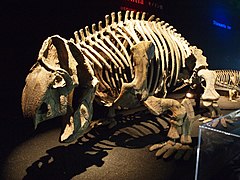Ischigualastia jenseni
|
Ischigualastia Temporal range: Late Triassic, 231.4 Ma |
|
|---|---|
 |
|
| Mounted skeleton of Ischigualastia jenseni | |
| Scientific classification | |
| Kingdom: | Animalia |
| Phylum: | Chordata |
| Class: | Synapsida |
| Order: | Therapsida |
| Suborder: | Anomodontia |
| Infraorder: | Dicynodontia |
| Family: | Stahleckeriidae |
| Genus: |
Ischigualastia Cox, 1962 |
| Species | |
|
|
Ischigualastia was a dicynodont (a group of synapsids) that lived during the Carnian age of the Late Triassic Period. From the Ischigualasto Formation of Argentina, it was a member of the family Stahleckeriidae.
An enormous dicynodont, with a short, high skull, and lacking tusks. It is regarded as larger than its later, more famous relative Placerias, which was up to 3.5 meters (11 feet) long and weighed one to two tonnes (1.1 to 2.2 short tons).
It was a large quadrupedal herbivore, most common at the base of the Ischigualasto Formation. It was a common member of the local fauna, although not as abundant as the medium-sized herbivores Scaphonyx and Exaeretodon. The only danger to such a huge animal was the almost equally large carnivorous pseudosuchian Saurosuchus and perhaps the predatory dinosaur Herrerasaurus, which shared the same environment. It is likely that pressure from this predator pushed Ischigualastia into extinction, for it becomes less common and finally disappears in the higher levels of the Ischigualasto Formation. A somewhat smaller relative or descendant, Placerias, survived in Laurasia.
...
Wikipedia
